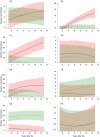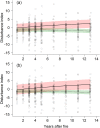Effects of forest wildfire on inner-Alpine bird community dynamics
- PMID: 31017942
- PMCID: PMC6481801
- DOI: 10.1371/journal.pone.0214644
Effects of forest wildfire on inner-Alpine bird community dynamics
Abstract
As major disturbance agents, natural catastrophes impact habitats, thereby maintaining the dynamics of ecological communities. Such discrete events are expected to positively affect biodiversity because they generate high habitat heterogeneity and thus numerous ecological niche opportunities. Species typical of open and semi-open habitats, which are often of high conservation concern in modern anthropized landscapes, may benefit most from recurrent natural catastrophes that regularly reset ecosystems. We investigated bird community changes and species-specific responses to wildfire at two recently burnt temperate, montane-subalpine forest stands in an inner-Alpine Swiss valley, with a special focus on red-listed and conservation priority species. We compared bird community changes in burnt forests (spanning 13 years) with bird assemblages occurring in adjacent non-burned forest stands that served as quasi-experimental controls. Strong species-specific responses to wildfire were evidenced, resulting in a dramatic post-fire decrease in overall bird abundance and species richness. Yet, red-listed bird species and conservation priority species in Switzerland were substantially more common in burnt than in control forest stands. Many red-listed species showed a bell-shaped numeric response to wildfire over time, suggesting low habitat suitability just after fire, high habitat suitability at pioneer and early stages of vegetation succession, followed by a long-term decrease in suitability while vegetation becomes denser, especially at ground level. As established for Mediterranean regions where wildfires are especially frequent, this study shows that forest fires can also boost the populations of red-listed and priority bird species typical of open and semi-open habitats in temperate biomes. Prescribed forest fire might represent a management option for preserving threatened elements of biodiversity despite the intense public debate it will trigger.
Conflict of interest statement
The authors have declared that no competing interests exist.
Figures



References
-
- Sousa WP. The role of disturbance in natural communities. Annu Rev Ecol Evol Syst. 1984;15:353–91.
-
- Brawn JD, Robinson SK, Thompson FR III. The role of disturbance in the ecology and conservation of birds. Annu Rev Ecol Evol Syst. 2001;32:251–76.
-
- White PS, Pickett STA. Natural disturbance and patch dynamics: an introduction In: Pickett STA, White PS, editors. The Ecology of Natural Disturbance and Patch Dynamics. Orlando: Academic Press; 1985. p. 3–13.
MeSH terms
Associated data
LinkOut - more resources
Full Text Sources
Other Literature Sources
Medical
Research Materials

